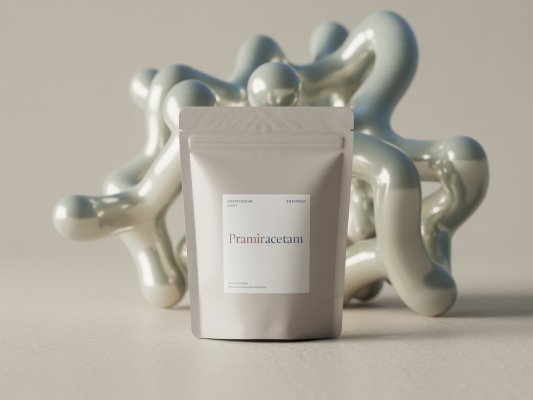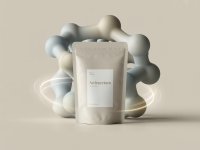
Pramiracetam
Description
Pramiracetam is a synthetic nootropic belonging to the racetam family, known for its potential to enhance cognitive function. Derived from piracetam, it's considered significantly more potent and is investigated for its effects on memory, focus, and learning. This article provides a comprehensive yet accessible overview of pramiracetam, designed for both supplement users and those seeking a quick understanding.
Quick Overview: Pramiracetam At-a-Glance
- Key Benefit(s): Enhanced memory formation and recall, increased focus and learning capacity.
- Primary Mechanism: Boosts high-affinity choline uptake in the hippocampus, increasing acetylcholine synthesis.
- Best For: Individuals seeking cognitive enhancement, particularly for memory and focus.
- Typical Dose Range: 400-1200mg daily, divided into 2-3 doses.
- Key Caution/Consideration: May cause headaches in some individuals; choline supplementation often recommended.
Table of Contents
Categories & Effectiveness
Learn about our rating methodologyNo categories available for this nootropic.
Dosage & Side Effects
Recommended Dosage
Potential Side Effects
Bioavailability & Half-Life
Interactions & Stacks
Recommended Products
Revitalize with Ceramosides™ & Lycopene for Skin Hydration, Wrinkles, Longevity - Advanced Cellular Rejuvenation Anti Aging Supplement - Hair Skin and Nails Vitamins - Made in USA - 60 Capsule
- Rated 4.2 stars by 16 customers
- Special offer: Save 10% with coupon
MATKAS Korean Gentle Tripeptide Lash Growth Serum for Lash and Brow - 8mL - Long Lash Serum for Eyelash Growth, Eyelash Conditioner and Eyebrow Conditioner for Volumizing Thickness and Length
- Rated 4.0 stars by 432 customers
- Premium quality ingredients
Pranarom Pure Essential Oil Aromaforce Throat Spray, Soothing Formula Including Citrus, Eucalyptus, Oregano, Lemon, 15ml
- Rated 4.2 stars by 62 customers
- Premium quality ingredients
As an Amazon Associate we earn from qualifying purchases. Prices and availability are accurate as of the date/time indicated and are subject to change.
Benefits by Use Case
Enhanced Memory Formation
Pramiracetam may improve long-term memory formation, encoding, and recall by increasing acetylcholine synthesis. Its effects on metamemory are also noted.
Increased Focus and Concentration
Pramiracetam can enhance focus, concentration, and mental clarity by modulating cholinergic neurotransmission. Individual responses may vary.
Mechanism of Action
Frequently Asked Questions
Where to Buy Pramiracetam
Based on quality, price, and customer reviews, here are our top recommended Pramiracetam supplements:
MATKAS Korean Gentle Tripeptide Lash Growth Serum for Lash and Brow - 8mL - Long Lash Serum for Eyelash Growth, Eyelash Conditioner and Eyebrow Conditioner for Volumizing Thickness and Length
- Rated 4.0 stars by 432 customers
- Premium quality ingredients
Revitalize with Ceramosides™ & Lycopene for Skin Hydration, Wrinkles, Longevity - Advanced Cellular Rejuvenation Anti Aging Supplement - Hair Skin and Nails Vitamins - Made in USA - 60 Capsule
- Rated 4.2 stars by 16 customers
- Special offer: Save 10% with coupon
Pranarom Pure Essential Oil Aromaforce Throat Spray, Soothing Formula Including Citrus, Eucalyptus, Oregano, Lemon, 15ml
- Rated 4.2 stars by 62 customers
- Premium quality ingredients
As an Amazon Associate we earn from qualifying purchases. Prices and availability are accurate as of the date/time indicated and are subject to change.
Summary & Expert Opinion
At a more granular level, pramiracetam's effects stem from its interaction with the cholinergic system. It specifically increases high-affinity choline uptake (HACU) at the nerve terminals in the hippocampus. This is a critical step in the synthesis of acetylcholine because the availability of choline often limits the rate of acetylcholine production. By enhancing HACU, pramiracetam ensures a more robust supply of choline for acetylcholine synthesis, leading to increased cholinergic neurotransmission.
Furthermore, pramiracetam's lipophilic nature allows it to readily cross the blood-brain barrier, ensuring it reaches its target sites in the brain effectively. The absence of significant metabolism and direct excretion in the urine also simplifies its pharmacokinetic profile. However, the long-term effects of chronic pramiracetam use on neurotransmitter systems are not fully understood. While it primarily affects the cholinergic system, indirect effects on other neurotransmitter systems cannot be ruled out.
It's also worth noting that animal studies have shown that pramiracetam does not cause demyelination at tested doses. However, these findings need to be replicated in human studies to confirm its long-term safety. Additionally, the precise mechanisms by which pramiracetam enhances membrane fluidity and cerebral blood flow require further investigation. These effects likely contribute to its overall cognitive-enhancing properties.







